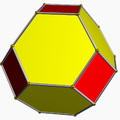- Tetrakis hexahedron
-
Tetrakis hexahedron 
(Click here for rotating model)Type Catalan solid Face type isosceles triangle Faces 24 Edges 36 Vertices 14 Vertices by type 6{4}+8{6} Face configuration V4.6.6 Symmetry group Oh, [4,3], *432 Dihedral angle 143°7'48"

Properties convex, face-transitive 
Truncated octahedron
(dual polyhedron)
NetIn geometry, a tetrakis hexahedron is a Catalan solid. Its dual is the truncated octahedron, an Archimedean solid. It can be seen as a cube with square pyramids covering each square face; that is, it is the Kleetope of the cube.
It also can be called a disdyakis hexahedron as the dual of an omnitruncated tetrahedron.
Contents
Uses
Naturally occurring (crystal) formations of tetrahexahedrons are observed in copper and fluorite systems.
Polyhedral dice shaped like the tetrakis hexahedron are occasionally used by gamers.
A 24-cell viewed under a vertex-first perspective projection has a surface topology of a tetrakis hexahedron and the geometric proportions of the rhombic dodecahedron, with the rhombic faces divided into two triangles.
Gallery
-
As tiling by reflection domain of (2,3,3) triangle group
See also
- Disdyakis triacontahedron
- Disdyakis dodecahedron
- Bisected hexagonal tiling
- Compound of three octahedra
References
- Williams, Robert (1979). The Geometrical Foundation of Natural Structure: A Source Book of Design. Dover Publications, Inc. ISBN 0-486-23729-X. (Section 3-9)
- Wenninger, Magnus (1983), Dual Models, Cambridge University Press, ISBN 978-0-521-54325-5, MR730208 (The thirteen semiregular convex polyhedra and their duals, Page 14, Tetrakishexahedron)
- The Symmetries of Things 2008, John H. Conway, Heidi Burgiel, Chaim Goodman-Strass, ISBN 978-1-56881-220-5 [1] (Chapter 21, Naming the Archimedean and Catalan polyhedra and tilings, page 284, Tetrakis hexahedron )
External links
- Eric W. Weisstein, Tetrakis hexahedron (Catalan solid) at MathWorld.
- Virtual Reality Polyhedra www.georgehart.com: The Encyclopedia of Polyhedra
- VRML model
- Conway Notation for Polyhedra Try: "dtO"
- Tetrakis Hexahedron -- Interactive Polyhedron model
- The Uniform Polyhedra
Polyhedron navigator Platonic solids (regular) Archimedean solids
(Semiregular/Uniform)Catalan solids
(Dual semiregular)triakis tetrahedron · rhombic dodecahedron · triakis octahedron · tetrakis cube · deltoidal icositetrahedron · disdyakis dodecahedron · pentagonal icositetrahedron · rhombic triacontahedron · triakis icosahedron · pentakis dodecahedron · deltoidal hexecontahedron · disdyakis triacontahedron · pentagonal hexecontahedronDihedral regular Dihedral uniform Duals of dihedral uniform Dihedral others Degenerate polyhedra are in italics.
This polyhedron-related article is a stub. You can help Wikipedia by expanding it. -


